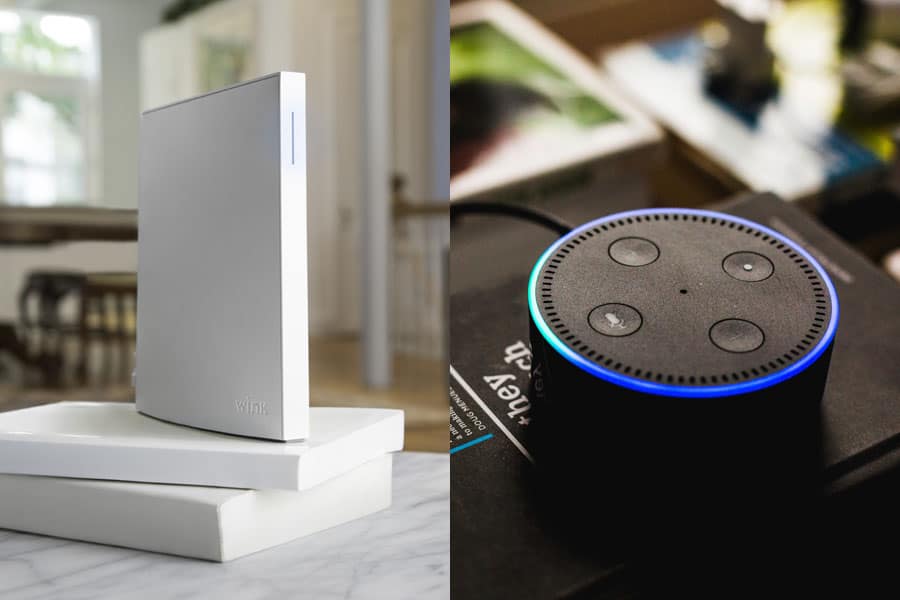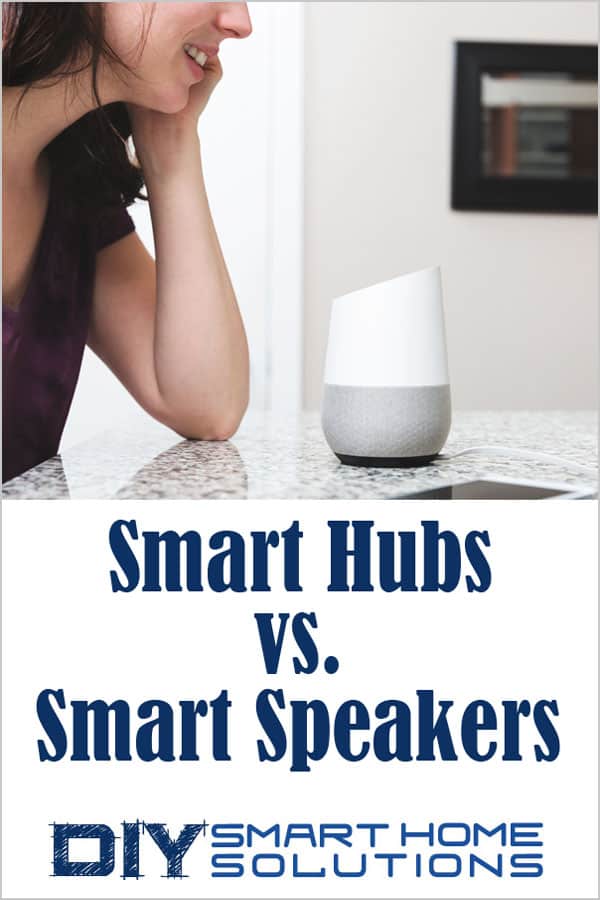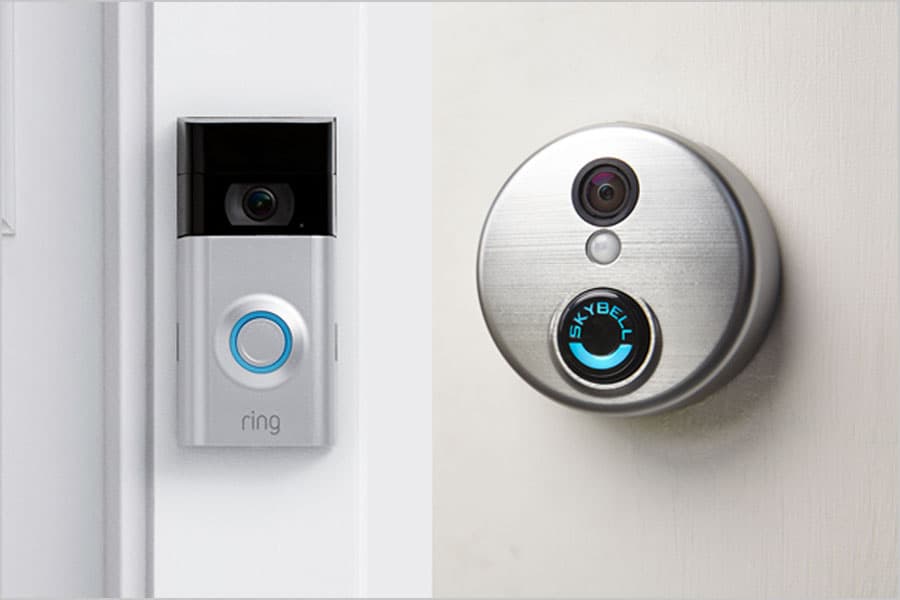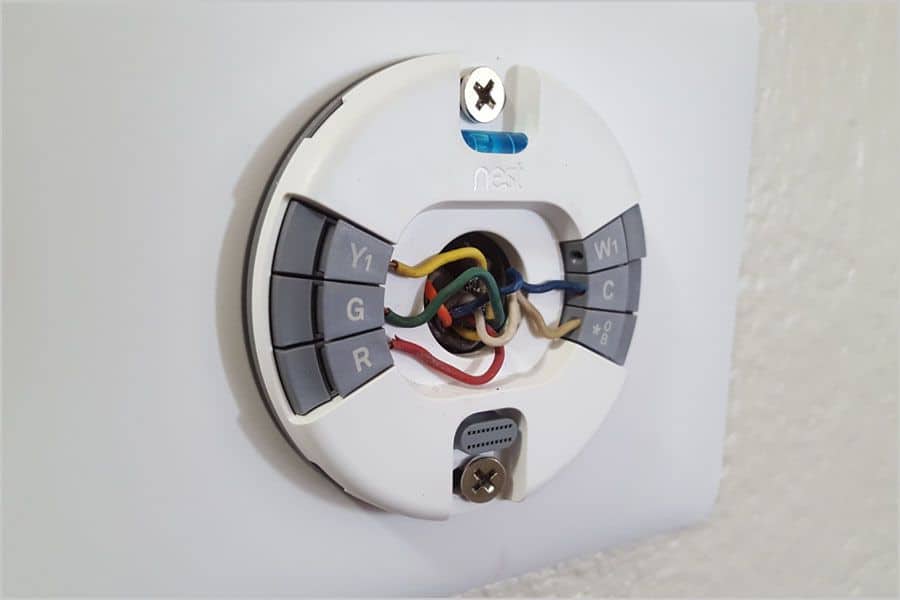Smart Hubs vs. Smart Speakers - How to Control Your Home Automation System
AUTHOR: Jon WellingUPDATED: November 20, 2024
When smart hubs first hit the market, they served as a command center for specific smart home devices within a single product line from a single manufacturer.
In recent years, the smart hub has evolved and now has the ability to connect devices across various product lines from various manufacturers. This adaptation allows for a deeper, more meaningful and advanced set of logic to control a wide range of functions for many different devices.
In this article, we’ll take a look at how the function and design of smart hubs has changed and how they are being used today. I’ll explain how smart speakers have become the smart hub of choice for home automation systems and how you can maximize their features and benefits.
So, sit back and get comfortable, as we take a closer look at smart hubs and smart speakers.
Smart Home Deals @ AmazonThe Evolution of the Smart Hub
For the most part, smart home devices operate within their own silos. A smart device can connect to the internet and to an app on your phone. This lets you control a singular device for a singular task. For example, the app for a smart garage door opener lets you open and close the garage door, but it can’t control anything else.
Eventually, manufacturers created a centralized hub which could control a specific line of devices in order to perform certain tasks. A popular example of this is the line of Philips Hue smart light bulbs (link to Amazon) that require a Philips Hue hub to control them.
This can lead to limitations in functionality, however. In the case of the Philips Hue hub, consumers can only control the lighting in their house and only with Philips Hue smart light bulbs. While Philips Hue bulbs do have amazing features and capabilities, you are limited to the functions Philips has implemented in their smart hub.
Other manufacturers saw this as an opening in the smart home market and created a more universal smart home hub. The Aeotec Smart Home Hub (link to Amazon) and Samsung SmartThings Hub (link to Amazon) are both good examples of this.
These hubs allow consumers to connect all of their smart home devices to a single hub. Some hubs can integrate Zigbee and Z-Wave connectivity which allows for future expandability to a broader range of products.
More recently, the functions of a smart hub have been taken over by smart speakers like the Amazon Echo (link to Amazon) and Google Nest Audio. Though there are still many smart hubs being sold, more people are starting to use smart speakers as their main automation hub.
The Amazon Echo and Google Home are two of the most popular smart speakers on the market today. I’ll be focusing most of the article on these two devices.
Differences Between Smart Hubs and Smart Speakers
Before we go any further, I want to explain a few key differences between smart hubs and smart speakers.
Smart hubs are more limited in nature because they typically only accept connections from Z-Wave and Zigbee devices.
Smart speakers and other Wi-Fi enabled devices inherently have more capabilities because they have a direct connection to the internet. This gives them access to more services which allows them to be more extensible and upgradable.
Zigbee and Z-Wave devices are limited to their firmware and hardware design. Once it's deployed, it's very hard to change it.
An advantage of something like the SmartThings Hub is that smart devices don’t have to be designed with it in mind. In other words, it’s up to Samsung (the current owner of SmartThings) to include the functionality to connect to devices from other manufacturers and not the other way around. This is another point that differs in smart speakers.
Instead of the Echo and Home having to create interoperability for new devices, device manufacturers must build in integration for Alexa and Google Assistant (Amazon’s and Google’s voice assistants) into their individual devices.
Both Amazon and Google provide an easy-to-understand API that lets any device creator allow Alexa and Google Assistant to control their device. Even a novice engineer, can buy a Raspberry Pi or Arduino board, create a smart home device, and control it with the Amazon Echo or Google Home.
The Amazon Echo and Google Home have a distinct advantage over smart hubs in that they are primarily controlled with your voice. Utilizing the technology of voice assistants gives them a unique interaction method and smarter backend. They have a very powerful cloud AI system that allows for more logical and creative interactions with your smart home devices.
If you think about it, that’s why the Echo and Home are now becoming the true standard in smart home hubs. It’s a lot more convenient to use voice commands than it is to use an app to control your home automation system. After all, the point of creating a smart home is to make every day, mundane tasks easier to accomplish and more automated.
While the function and design of the smart home hub has evolved significantly over time, the primary idea of having one is still intact: the ability to control all of your smart home devices from a centralized place. With that in mind, let’s take a look at the features and benefits of using a smart speaker as the hub for your home automation system.
Using a Smart Speaker as a Hub
What makes the Amazon Echo and Google Home so powerful is they not only connect with smart home devices, but they also connect to other apps and services as well. I think the best way to showcase the benefits of using a smart speaker as a hub is by walking you through my typical day.
I wake up in the morning, head downstairs, take the dog out, feed the cats, and then make some coffee. On my way downstairs, I, very sleepily, ask Alexa to turn on my living room light. I’m always groggy in the morning, so I don’t want to fumble around in the dark to find the light switch (I wake up at 5 a.m.).
After the coffee is done and the dog is fed, I like to take a few minutes to wake up. I’ll sit at the kitchen table, sip my coffee, and ask Alexa what my schedule is like for the day and what’s in the news. Alexa will typically go on a 20-minute rant telling me what’s on my calendar, what’s scheduled to get done on my to-do list, run through all my news apps, and tell me what the weather is like.
After all of that, I’m finally awake. I work from home and I like to listen to music while working. I’ll ask Alexa to play music, but only downstairs. My wife sleeps in later then I do, and I don’t want to wake her up. Music will then start playing quietly on my connected speakers, only on the first floor of my home.
Then it’s breakfast time. I’ll cook myself a few eggs, some toast, and make another cup of coffee. I’ll also take a moment to scrounge the fridge and cupboards to see if there’s anything I need to pick up while I’m out of the house. With my head stuck in the fridge, I’ll yell over to Alexa to add eggs, coffee, or whatever else I need to my shopping list. That list is synced to an app on my phone. If I need to run any other errands today, I’ll ask Alexa to add that to my to-do list, as well.
After that, I’ll wake up my wife, if she didn’t hear the alarm clock. It’s a common occurrence in our house. I’ll ask Alexa to, once again, play music, but this time upstairs. If she doesn’t wake up after 15 minutes, I’ll ask Alexa to play songs from The Dropkick Murphy’s in the bedroom. That’ll usually get her up. By the time she wakes up, the sun has come up, so Alexa will turn off the living room lights for me. We only have sheer curtains on our front and back windows so we get plenty of sunlight in our house.
The day continues... At 5:30 p.m., Alexa turns our lights back on for us. This is the time I’ve scheduled that works best for us. During the summer, my wife and I like to go sit out on the front porch and have a drink. I’ll ask Alexa to turn on our porch lights and set them to 10% lighting. When we leave the house, I typically don’t even bother turning on the porch lights. When we come back home, I ask Alexa, on my phone, to turn on the porch lights. That way we aren’t wasting electricity by keeping the lights on all the time.
One of my favorite things to do on the weekend is watching movies with my wife. I also really love buttery popcorn. Buttery popcorn and TV remotes don’t work well together. My wife also doesn’t appreciate it if I wipe my hands on my pants. So when I need to get up, pause the movie, or turn the volume up or down on our surround sound system, it’s nice to be able to ask Alexa to do that for me. That way I don’t have to touch the remote.
Using the Amazon Echo as the hub for my home automation system allows me to freely design my smart home strategies around my habits. I’ve created these functionalities and integrated certain smart home devices around how I go about my day. I wasn’t limited by what smart home devices I could buy or what apps I could use. That is the beauty in using a smart speaker like the Amazon Echo or Google Home for a smart hub.
How Do Smart Hubs Connect?
Smart hubs connect to devices in a variety of ways, though most of them have been standardized now. We are going to breeze through this section very quickly with only a few notes.
Wi-Fi
Because of the Amazon Echo and Google Home, Wi-Fi has become the standard connection method for smart home devices. Wi-Fi connectivity is cheap and easy to include in any smart home device. It follows application standards rather than hardware standards for connectivity and interoperability. That means, it’s far easier for device manufacturers to update the smart home device in the future. Because of this, I highly recommend that you have a good wireless router or home mesh network installed in your house.
Bluetooth
Very few devices use Bluetooth for anything more than setting them up. It’s become more commonplace to do setup via Wi-Fi nowadays.
3G/4G/5G
Smart home hubs typically don’t work over cell networks. They need a constant, stable connection. With that said, the beauty of the Amazon Echo and Google Home is that you can use their apps on your phone to control your home even when you’re miles away.
Zigbee and Z-Wave
Zigbee and Z-Wave were once the standards for connecting smart home devices, but they’re not the only option anymore. It used to be that if you had Zigbee or Z-Wave devices, you needed a smart hub that had those connectivity options. Alexa is now compatible with Zigbee devices which alleviates some of that concern. However, Google has yet to integrate Zigbee and Z-wave connectivity, which is a common gripe against the Google Home.
Smart Hub Security Risks
Smart hubs themselves aren’t a big security risk. Smart hubs are usually segregated behind a personal network of some kind. Most smart hubs and smart home devices require some kind of authentication to connect with them initially.
In a smart home, the threat isn’t with the smart hub, but rather the smart home device itself. Smart home devices are connecting to the internet more and more and manufacturers don’t invest a lot in internet security.
We are going to see laws and regulations change that over time, but for the moment, it is a cause for concern. In the meantime, try to avoid cheaper smart home gadgets and only buy from reputable sources.
Be sure to check out our article on how smart home automation systems can get hacked. We list various ways hackers can infiltrate home automation systems and offer tips to avoid those risks.
Do You Need a Smart Home Hub?
In most of my articles, I usually give a nuanced answer as to whether or not you really need to buy or own a certain product. After all, most products have specific use cases and you can never automatically assume one answer for everyone.
This time I’m going to defer away from my standard and instead simply offer a resounding, YES. Yes, you do need a smart home hub.
Individual smart home gadgets work well on their own, but they only provide a singular answer to singular problem. And fumbling around with multiple apps to control multiple devices in not at all convenient.
Using the Amazon Echo or Google Home as a smart hub, consolidates all of your smart home devices and allows you to use them in a logical way that can automate multiple tasks, making your life simpler and much more enjoyable.
Hopefully the information in this article and the description of how I go about my typical day was able to demonstrate the many benefits of using a smart hub in your home automation system. If I didn’t have a smart hub, much less a smart speaker like the Amazon Echo or Google Home, none of the functionality I described would be possible.
Recommended Products
- Our best sounding Echo Dot yet – Enjoy an improved audio experience compared to any previous Echo Dot with Alexa for...
- Your favorite music and content – Play music, audiobooks, and podcasts from Amazon Music, Apple Music, Spotify and others...
- Alexa is happy to help – Ask Alexa for weather updates and to set hands-free timers, get answers to your questions and even...
- Keep your home comfortable – Control compatible smart home devices with your voice and routines triggered by built-in...
- Designed to protect your privacy – Amazon is not in the business of selling your personal information to others. Built with...
No products found.
- Enjoy an immersive audio experience - Echo Studio now features spatial audio processing technology for a wider and more...
- Voice control your music – Stream songs from Amazon Music, Apple Music, Spotify, Pandora, Tidal, and more. With Amazon...
- Adapts to any room – Automatically senses the acoustics of your space, fine-tuning playback for optimal sound.
- Built-in smart home hub – ask Alexa to control Zigbee and Matter-compatible devices.
- Ready to help – Ask Alexa to play music, read the news, and answer questions.
- Alexa can show you even more - With a 10.1" HD screen that’s designed to move with you, video calls, recipes, and shows are...
- Stay in frame - Video call friends and family or take a picture while the 13MP camera with auto-framing and motion keeps you...
- Smart home made simple - Set up compatible Zigbee and Matter devices without a separate hub. Ask Alexa to show you security...
- Take a look around when you’re away - Securely access the built-in camera to remotely monitor your home anytime with the...
- So much entertainment - Ask Alexa to play your favorite shows, music, and podcasts from Prime Video, Netflix, Amazon Music,...
- Better inside and out – Entertainment is more immersive with spatial audio and an 8" HD touchscreen. Video calling is...
- Vibrant sights, full sound – Content on Prime Video, Netflix, Fire TV Channels, and more comes to life with an HD display...
- Smart home, simplified – Pair and control devices compatible with Zigbee, Matter, and Thread without a separate smart home...
- Stay in the loop – Video call hands-free using your voice, or use the new Top Connections widget to call with one tap. Have...
- Show off your good times – Amazon Photos turns your home screen into a digital frame of favorite memories, and adaptive...
- Easiest way to make your home a smart home: Wirelessly connect and control a huge range of smart devices - over 5,000 are...
- Automate connected devices: Any device you connect can be included into automations which can be intelligently managed. Now...
- Control via App or Voice: Monitor and control connected devices, and run automations, using the Samsung SmartThings app on...
- Requires internet access for set-up: Ethernet connection recommended, but Wi-Fi is also available. Download the SmartThings...
- Compatibility: Certified to work with Google, Alexa, SmartThings, Matter, Wi-Fi, Z-Wave Plus, and ZigBee protocols. Not...
- Monitor and control compatible devices in your home using a single smartphone app for your phone
- Automate connected devices in your home and set them to turn on or off when doors are opened, people come and go, and much...
- Works with a wide range of smartphone compatible products
- With the Hubitat Elevation C-8, you can easily control and automate lights, locks, switches, dimmers, blinds, thermostats,...
- ENHANCED CAPABILITIES: The Hubitat Elevation Model C-8 is designed to seamlessly support standard ZIGBEE, Z-WAVE, and MATTER...
- MATTER-compatible and integrates with MATTER BRIDGES, which convert Zigbee or Z-Wave devices into Matter devices. This...
- LOCALLY PROCESSED AUTOMATIONS: Automations are processed locally on the hub for speed, reliability, and privacy, so your home...
- VERSATILE INTEGRATIONS: Compatible with over 1,000 smart devices from over 100 brands, including: Apple HomeKit, Amazon...






